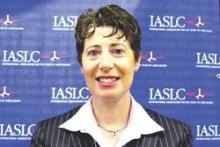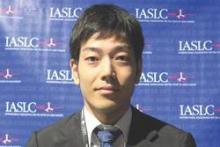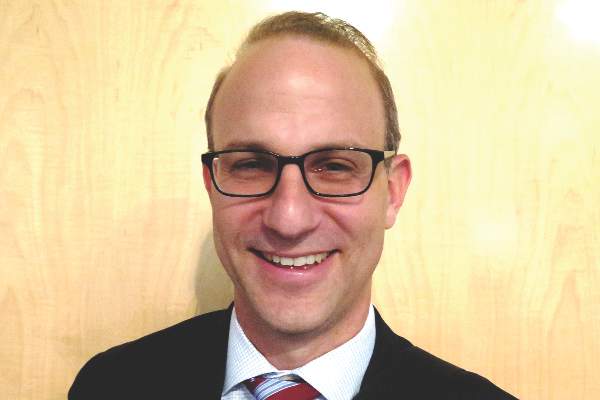User login
DENVER – Genomic testing in young patients with lung cancer is critical, as the majority have adenocarcinomas harboring driver alterations that can be targeted with drugs available today, suggested a trio of cohort studies presented at a conference sponsored by the International Association for the Study of Lung Cancer.
More than three-fourths of patients aged 40 years or younger with adenocarcinoma were found to have driver alterations in genes such as those for epidermal growth factor receptor (EGFR), anaplastic lymphoma kinase (ALK), and ROS proto-oncogene 1 (ROS1), investigators reported in a session and related press conference.
“Lung cancer under 40 is a group of patients who are enriched for actionable mutations,” commented invited discussant Dr. Benjamin Levy, assistant professor of medicine, Mount Sinai School of Medicine; medical director of the thoracic oncology program for the Mount Sinai Health System; and associate director of the cancer clinical trials office at Mount Sinai Hospital – all in New York. “I think that if there was ever a clinical circumstance in which next-generation sequencing should be performed routinely outside a clinical trial, it’s for these patients under 40.”
Of note, in two of the three studies, the majority of patients had some history of smoking, “suggesting that this lung cancer in patients under 40 is not necessarily a nonsmoking disease,” he said. “It’s wonderful to have great drugs for those patients who do develop lung cancer, but instituting preventive measures for tobacco control and education does wonders.”
New study design expands enrollment options
In the first study, a team led by Dr. Barbara J. Gitlitz, associate professor of clinical medicine at the University of Southern California in Los Angeles, analyzed data from the Genomics of Young Lung Cancer Study, the first to prospectively assess clinical characteristics and genomic alterations of this population.
The study is open to patients younger than 40 years at diagnosis. All are tested for alterations of EGFR, BRAF, HER2, KRAS, ALK, ROS1, and RET, and those negative for alterations in these genes have additional testing.
“One interesting point of our study is that people can enter either through coming to a [brick and mortar] site that has IRB approval or through a website (https://www.openmednet.org/site/alcmi-goyl) where people can remotely consent anywhere in the world and participate in our clinical trial,” Dr. Gitlitz noted.
In fact, of the 68 patients enrolled in the first year, 44% did so through the website, including some from as far away as Australia, Norway, and Turkey. The patients ranged in age from 16 to 39 years at diagnosis (median, 35 years), and 52% were female. They tended to be never-smokers, Dr. Gitlitz reported.
Fifty of the patients had stage IV adenocarcinoma at diagnosis. In this group, 76% were found to have known actionable driver alterations – most commonly in ALK (44%), EGFR (26%), or ROS1 (6%). The prevalence was higher among women than men (95% vs 74%), “so there might be a different genomic spectrum of females to males,” she said.
Another 14% had other driver mutations identified, most of which also were targetable. Of note, this group included a young man found to have a previously unknown EGFR kinase domain duplication who had a response to afatinib (Cancer Discov. 2015 Aug. 18. doi: 10.1158/2159-8290.CD-15-0654). “So a new, actionable EGFR mutation has been discovered through looking at young-emergent lung cancer,” noted Dr. Gitlitz.
“We hypothesized that this cohort may be a special population enriched for driver mutations, but we have far exceeded our statistical expectations, with the majority having an actionable mutation for which they are on targeted therapy, greater than 76%,” she said. “A website allowing for virtual consenting so that patients can participate remotely and use social networking to share trial information is a novel, feasible way to conduct research across continents.”
“We will continue accrual for at least another year, and my plea at this international congress is that we would very much love more international participation,” she concluded. “Ultimately, we plan a follow-up study, Epidemiology of Young Lung Cancer, to build upon our unique web-based, patient-engaged trial design.”
Dr. Levy, the discussant, commented, “This study should be lauded … for taking the additional steps to look at both somatic and germline mutations via whole-exome next-generation sequencing, and also pushing the envelope for those who have no matching mutation in evaluating relevant alterations via next-generation sequencing and cell-free DNA.”
He also commended the novel web-based recruitment and consenting design, saying, “We have to put this in the context that only 5% of all lung cancer patients go on clinical trials. Anything we can do that’s novel or outside the box, as done here, is a welcome change.”
ALK translocations predominate
In the second study, Dr. Kosuke Tanaka of the department of thoracic oncology at Aichi Cancer Center Hospital in Nagoya, Japan, performed retrospective genomic screening of 67 consecutive patients who received a diagnosis of lung adenocarcinoma when aged 40 years or younger.
All patients had evaluation for EGFR and KRAS mutations, and most had evaluation for ALK translocations. Those negative for all three had additional testing.
The patients had a median age of 36 years, 60% were female, and 68% had stage IV disease, Dr. Tanaka reported. The majority, 61%, were former or current smokers.
Overall, 82% of the patients were found to have targetable alterations of driver oncogenes. The most common were ALK translocation (seen in 45%) and EGFR mutation (27%); KRAS mutation was uncommon (3%). Among 15 patients known to be negative for all of these, analyses identified HER2 mutations in three and RET mutations in two.
Driver mutations were more common among patients who had no or only a light smoking history, compared with peers who smoked (89% vs. 72%, P = .069). ALK translocation was more common in patients with stage IV disease (58% vs. 18%, P = .002).
“Early-emerging adenocarcinoma has a very high possibility of having some targetable driver oncogenes,” Dr. Tanaka concluded. “Among younger populations, examination of all known oncogenes, including minor ones, is strongly recommended.”
Data finger genes involved in cell adhesion
In the third study, investigators performed genomic analysis in 20 patients from the Cleveland Clinic who underwent surgery for non–small-cell lung cancer (NSCLC) that was diagnosed at age 45 years or younger.
Overall, 60% were female and 65% had smoked at some time, reported lead author Dr. Patrick C. Ma of the Mary Babb Randolph Cancer Center at West Virginia University, Morgantown, and the Sun Yat-sen University Cancer Center’s State Key Laboratory of Oncology in South China and the Collaborative Innovation Center for Cancer Medicine, Guangzhou, China.
Some 55% of patients had adenocarcinomas, and 20% had stage IV disease. Of note, 25% had a history of some other type of cancer and 60% had a first-degree relative with a cancer diagnosis.
The somatic mutation rate was much higher in ever-smokers than never-smokers (3.47 vs. 0.76 per megabase). The former value “is a relatively high mutational burden, standing shoulder to shoulder with melanoma and bladder cancer,” Dr. Ma pointed out.
Mutations of key driver genes such as TP53 and KRAS were seen exclusively in smokers, but EGFR mutations were more often seen in never-smokers.
Further analyses indicated that genes involved in cell adhesion and epithelial-mesenchymal transition (EMT) showed a sevenfold enrichment in mutation frequency in the cohort, compared with that seen in the lung cancer data set of the Cancer Genome Atlas.
“Our study nominated novel candidate genes and pathways especially related to cell adhesion and EMT process that potentially may play a role in early-onset NSCLC, whether in smokers or nonsmokers,” Dr. Ma said.
“Further analysis and validation of our findings will improve our understanding of lung cancer pathogenesis, especially in younger patients, and eventually lead to precision therapies to benefit these younger patients,” he concluded.
Dr. Gitlitz disclosed that she is on the speakers bureaus of Genentech and Eli Lilly. Dr. Tanaka and Dr. Ma disclosed that they had no relevant conflicts of interest.
DENVER – Genomic testing in young patients with lung cancer is critical, as the majority have adenocarcinomas harboring driver alterations that can be targeted with drugs available today, suggested a trio of cohort studies presented at a conference sponsored by the International Association for the Study of Lung Cancer.
More than three-fourths of patients aged 40 years or younger with adenocarcinoma were found to have driver alterations in genes such as those for epidermal growth factor receptor (EGFR), anaplastic lymphoma kinase (ALK), and ROS proto-oncogene 1 (ROS1), investigators reported in a session and related press conference.
“Lung cancer under 40 is a group of patients who are enriched for actionable mutations,” commented invited discussant Dr. Benjamin Levy, assistant professor of medicine, Mount Sinai School of Medicine; medical director of the thoracic oncology program for the Mount Sinai Health System; and associate director of the cancer clinical trials office at Mount Sinai Hospital – all in New York. “I think that if there was ever a clinical circumstance in which next-generation sequencing should be performed routinely outside a clinical trial, it’s for these patients under 40.”
Of note, in two of the three studies, the majority of patients had some history of smoking, “suggesting that this lung cancer in patients under 40 is not necessarily a nonsmoking disease,” he said. “It’s wonderful to have great drugs for those patients who do develop lung cancer, but instituting preventive measures for tobacco control and education does wonders.”
New study design expands enrollment options
In the first study, a team led by Dr. Barbara J. Gitlitz, associate professor of clinical medicine at the University of Southern California in Los Angeles, analyzed data from the Genomics of Young Lung Cancer Study, the first to prospectively assess clinical characteristics and genomic alterations of this population.
The study is open to patients younger than 40 years at diagnosis. All are tested for alterations of EGFR, BRAF, HER2, KRAS, ALK, ROS1, and RET, and those negative for alterations in these genes have additional testing.
“One interesting point of our study is that people can enter either through coming to a [brick and mortar] site that has IRB approval or through a website (https://www.openmednet.org/site/alcmi-goyl) where people can remotely consent anywhere in the world and participate in our clinical trial,” Dr. Gitlitz noted.
In fact, of the 68 patients enrolled in the first year, 44% did so through the website, including some from as far away as Australia, Norway, and Turkey. The patients ranged in age from 16 to 39 years at diagnosis (median, 35 years), and 52% were female. They tended to be never-smokers, Dr. Gitlitz reported.
Fifty of the patients had stage IV adenocarcinoma at diagnosis. In this group, 76% were found to have known actionable driver alterations – most commonly in ALK (44%), EGFR (26%), or ROS1 (6%). The prevalence was higher among women than men (95% vs 74%), “so there might be a different genomic spectrum of females to males,” she said.
Another 14% had other driver mutations identified, most of which also were targetable. Of note, this group included a young man found to have a previously unknown EGFR kinase domain duplication who had a response to afatinib (Cancer Discov. 2015 Aug. 18. doi: 10.1158/2159-8290.CD-15-0654). “So a new, actionable EGFR mutation has been discovered through looking at young-emergent lung cancer,” noted Dr. Gitlitz.
“We hypothesized that this cohort may be a special population enriched for driver mutations, but we have far exceeded our statistical expectations, with the majority having an actionable mutation for which they are on targeted therapy, greater than 76%,” she said. “A website allowing for virtual consenting so that patients can participate remotely and use social networking to share trial information is a novel, feasible way to conduct research across continents.”
“We will continue accrual for at least another year, and my plea at this international congress is that we would very much love more international participation,” she concluded. “Ultimately, we plan a follow-up study, Epidemiology of Young Lung Cancer, to build upon our unique web-based, patient-engaged trial design.”
Dr. Levy, the discussant, commented, “This study should be lauded … for taking the additional steps to look at both somatic and germline mutations via whole-exome next-generation sequencing, and also pushing the envelope for those who have no matching mutation in evaluating relevant alterations via next-generation sequencing and cell-free DNA.”
He also commended the novel web-based recruitment and consenting design, saying, “We have to put this in the context that only 5% of all lung cancer patients go on clinical trials. Anything we can do that’s novel or outside the box, as done here, is a welcome change.”
ALK translocations predominate
In the second study, Dr. Kosuke Tanaka of the department of thoracic oncology at Aichi Cancer Center Hospital in Nagoya, Japan, performed retrospective genomic screening of 67 consecutive patients who received a diagnosis of lung adenocarcinoma when aged 40 years or younger.
All patients had evaluation for EGFR and KRAS mutations, and most had evaluation for ALK translocations. Those negative for all three had additional testing.
The patients had a median age of 36 years, 60% were female, and 68% had stage IV disease, Dr. Tanaka reported. The majority, 61%, were former or current smokers.
Overall, 82% of the patients were found to have targetable alterations of driver oncogenes. The most common were ALK translocation (seen in 45%) and EGFR mutation (27%); KRAS mutation was uncommon (3%). Among 15 patients known to be negative for all of these, analyses identified HER2 mutations in three and RET mutations in two.
Driver mutations were more common among patients who had no or only a light smoking history, compared with peers who smoked (89% vs. 72%, P = .069). ALK translocation was more common in patients with stage IV disease (58% vs. 18%, P = .002).
“Early-emerging adenocarcinoma has a very high possibility of having some targetable driver oncogenes,” Dr. Tanaka concluded. “Among younger populations, examination of all known oncogenes, including minor ones, is strongly recommended.”
Data finger genes involved in cell adhesion
In the third study, investigators performed genomic analysis in 20 patients from the Cleveland Clinic who underwent surgery for non–small-cell lung cancer (NSCLC) that was diagnosed at age 45 years or younger.
Overall, 60% were female and 65% had smoked at some time, reported lead author Dr. Patrick C. Ma of the Mary Babb Randolph Cancer Center at West Virginia University, Morgantown, and the Sun Yat-sen University Cancer Center’s State Key Laboratory of Oncology in South China and the Collaborative Innovation Center for Cancer Medicine, Guangzhou, China.
Some 55% of patients had adenocarcinomas, and 20% had stage IV disease. Of note, 25% had a history of some other type of cancer and 60% had a first-degree relative with a cancer diagnosis.
The somatic mutation rate was much higher in ever-smokers than never-smokers (3.47 vs. 0.76 per megabase). The former value “is a relatively high mutational burden, standing shoulder to shoulder with melanoma and bladder cancer,” Dr. Ma pointed out.
Mutations of key driver genes such as TP53 and KRAS were seen exclusively in smokers, but EGFR mutations were more often seen in never-smokers.
Further analyses indicated that genes involved in cell adhesion and epithelial-mesenchymal transition (EMT) showed a sevenfold enrichment in mutation frequency in the cohort, compared with that seen in the lung cancer data set of the Cancer Genome Atlas.
“Our study nominated novel candidate genes and pathways especially related to cell adhesion and EMT process that potentially may play a role in early-onset NSCLC, whether in smokers or nonsmokers,” Dr. Ma said.
“Further analysis and validation of our findings will improve our understanding of lung cancer pathogenesis, especially in younger patients, and eventually lead to precision therapies to benefit these younger patients,” he concluded.
Dr. Gitlitz disclosed that she is on the speakers bureaus of Genentech and Eli Lilly. Dr. Tanaka and Dr. Ma disclosed that they had no relevant conflicts of interest.
DENVER – Genomic testing in young patients with lung cancer is critical, as the majority have adenocarcinomas harboring driver alterations that can be targeted with drugs available today, suggested a trio of cohort studies presented at a conference sponsored by the International Association for the Study of Lung Cancer.
More than three-fourths of patients aged 40 years or younger with adenocarcinoma were found to have driver alterations in genes such as those for epidermal growth factor receptor (EGFR), anaplastic lymphoma kinase (ALK), and ROS proto-oncogene 1 (ROS1), investigators reported in a session and related press conference.
“Lung cancer under 40 is a group of patients who are enriched for actionable mutations,” commented invited discussant Dr. Benjamin Levy, assistant professor of medicine, Mount Sinai School of Medicine; medical director of the thoracic oncology program for the Mount Sinai Health System; and associate director of the cancer clinical trials office at Mount Sinai Hospital – all in New York. “I think that if there was ever a clinical circumstance in which next-generation sequencing should be performed routinely outside a clinical trial, it’s for these patients under 40.”
Of note, in two of the three studies, the majority of patients had some history of smoking, “suggesting that this lung cancer in patients under 40 is not necessarily a nonsmoking disease,” he said. “It’s wonderful to have great drugs for those patients who do develop lung cancer, but instituting preventive measures for tobacco control and education does wonders.”
New study design expands enrollment options
In the first study, a team led by Dr. Barbara J. Gitlitz, associate professor of clinical medicine at the University of Southern California in Los Angeles, analyzed data from the Genomics of Young Lung Cancer Study, the first to prospectively assess clinical characteristics and genomic alterations of this population.
The study is open to patients younger than 40 years at diagnosis. All are tested for alterations of EGFR, BRAF, HER2, KRAS, ALK, ROS1, and RET, and those negative for alterations in these genes have additional testing.
“One interesting point of our study is that people can enter either through coming to a [brick and mortar] site that has IRB approval or through a website (https://www.openmednet.org/site/alcmi-goyl) where people can remotely consent anywhere in the world and participate in our clinical trial,” Dr. Gitlitz noted.
In fact, of the 68 patients enrolled in the first year, 44% did so through the website, including some from as far away as Australia, Norway, and Turkey. The patients ranged in age from 16 to 39 years at diagnosis (median, 35 years), and 52% were female. They tended to be never-smokers, Dr. Gitlitz reported.
Fifty of the patients had stage IV adenocarcinoma at diagnosis. In this group, 76% were found to have known actionable driver alterations – most commonly in ALK (44%), EGFR (26%), or ROS1 (6%). The prevalence was higher among women than men (95% vs 74%), “so there might be a different genomic spectrum of females to males,” she said.
Another 14% had other driver mutations identified, most of which also were targetable. Of note, this group included a young man found to have a previously unknown EGFR kinase domain duplication who had a response to afatinib (Cancer Discov. 2015 Aug. 18. doi: 10.1158/2159-8290.CD-15-0654). “So a new, actionable EGFR mutation has been discovered through looking at young-emergent lung cancer,” noted Dr. Gitlitz.
“We hypothesized that this cohort may be a special population enriched for driver mutations, but we have far exceeded our statistical expectations, with the majority having an actionable mutation for which they are on targeted therapy, greater than 76%,” she said. “A website allowing for virtual consenting so that patients can participate remotely and use social networking to share trial information is a novel, feasible way to conduct research across continents.”
“We will continue accrual for at least another year, and my plea at this international congress is that we would very much love more international participation,” she concluded. “Ultimately, we plan a follow-up study, Epidemiology of Young Lung Cancer, to build upon our unique web-based, patient-engaged trial design.”
Dr. Levy, the discussant, commented, “This study should be lauded … for taking the additional steps to look at both somatic and germline mutations via whole-exome next-generation sequencing, and also pushing the envelope for those who have no matching mutation in evaluating relevant alterations via next-generation sequencing and cell-free DNA.”
He also commended the novel web-based recruitment and consenting design, saying, “We have to put this in the context that only 5% of all lung cancer patients go on clinical trials. Anything we can do that’s novel or outside the box, as done here, is a welcome change.”
ALK translocations predominate
In the second study, Dr. Kosuke Tanaka of the department of thoracic oncology at Aichi Cancer Center Hospital in Nagoya, Japan, performed retrospective genomic screening of 67 consecutive patients who received a diagnosis of lung adenocarcinoma when aged 40 years or younger.
All patients had evaluation for EGFR and KRAS mutations, and most had evaluation for ALK translocations. Those negative for all three had additional testing.
The patients had a median age of 36 years, 60% were female, and 68% had stage IV disease, Dr. Tanaka reported. The majority, 61%, were former or current smokers.
Overall, 82% of the patients were found to have targetable alterations of driver oncogenes. The most common were ALK translocation (seen in 45%) and EGFR mutation (27%); KRAS mutation was uncommon (3%). Among 15 patients known to be negative for all of these, analyses identified HER2 mutations in three and RET mutations in two.
Driver mutations were more common among patients who had no or only a light smoking history, compared with peers who smoked (89% vs. 72%, P = .069). ALK translocation was more common in patients with stage IV disease (58% vs. 18%, P = .002).
“Early-emerging adenocarcinoma has a very high possibility of having some targetable driver oncogenes,” Dr. Tanaka concluded. “Among younger populations, examination of all known oncogenes, including minor ones, is strongly recommended.”
Data finger genes involved in cell adhesion
In the third study, investigators performed genomic analysis in 20 patients from the Cleveland Clinic who underwent surgery for non–small-cell lung cancer (NSCLC) that was diagnosed at age 45 years or younger.
Overall, 60% were female and 65% had smoked at some time, reported lead author Dr. Patrick C. Ma of the Mary Babb Randolph Cancer Center at West Virginia University, Morgantown, and the Sun Yat-sen University Cancer Center’s State Key Laboratory of Oncology in South China and the Collaborative Innovation Center for Cancer Medicine, Guangzhou, China.
Some 55% of patients had adenocarcinomas, and 20% had stage IV disease. Of note, 25% had a history of some other type of cancer and 60% had a first-degree relative with a cancer diagnosis.
The somatic mutation rate was much higher in ever-smokers than never-smokers (3.47 vs. 0.76 per megabase). The former value “is a relatively high mutational burden, standing shoulder to shoulder with melanoma and bladder cancer,” Dr. Ma pointed out.
Mutations of key driver genes such as TP53 and KRAS were seen exclusively in smokers, but EGFR mutations were more often seen in never-smokers.
Further analyses indicated that genes involved in cell adhesion and epithelial-mesenchymal transition (EMT) showed a sevenfold enrichment in mutation frequency in the cohort, compared with that seen in the lung cancer data set of the Cancer Genome Atlas.
“Our study nominated novel candidate genes and pathways especially related to cell adhesion and EMT process that potentially may play a role in early-onset NSCLC, whether in smokers or nonsmokers,” Dr. Ma said.
“Further analysis and validation of our findings will improve our understanding of lung cancer pathogenesis, especially in younger patients, and eventually lead to precision therapies to benefit these younger patients,” he concluded.
Dr. Gitlitz disclosed that she is on the speakers bureaus of Genentech and Eli Lilly. Dr. Tanaka and Dr. Ma disclosed that they had no relevant conflicts of interest.
AT THE IASLC WORLD CONFERENCE
Key clinical point: The majority of young patients with lung cancer have mutations for which targeted therapies are available.
Major finding: Actionable mutations were found in more than 76% of patients with stage IV adenocarcinoma and in 82% of patients with any-stage adenocarcinoma. Sizable proportions of patients had a smoking history.
Data source: Three cohort studies in 68 patients younger than 40 years, 67 patients aged 40 or younger, and 20 patients aged 45 or younger at lung cancer diagnosis.
Disclosures: Dr. Gitlitz reported that she is on the speakers bureaus of Genentech and Eli Lilly. Dr. Tanaka reported that he had no relevant conflicts of interest. Dr. Ma reported that he had no relevant conflicts of interest.




